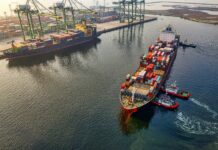
The Liberian Registry, the world’s largest shipping registry, will aid in the design approval process for the pioneering application of independent tank liquefied gas carriers.
This innovative approach, developed by HD Hyundai Group’s affiliates HD Hyundai Heavy Industries, HD Korea Shipbuilding & Offshore Engineering, and Hyundai Mipo Dockyard, has secured Design Approval for the “High-strength Composite Hybrid Support of the Independent Tanks Liquefied Gas Carriers” from Lloyd’s Register (LR), Det Norske Veritas (DNV), and the Liberian International Ship & Corporate Registry (LISCR).
These independent tanks, crucial for storing liquefied gas, demand robust support structures that can withstand various loads while remaining separate from the vessel’s hull. The newly developed hybrid support structure allows for the rearranging of existing layouts, enhancing structural integrity, and minimizing the necessity for high-risk inspections and works in elevated areas.
“This innovative independent tank support structures solution, by utilizing composite fusion to optimize performance and reduce risks during surveys and inspections, is a great achievement. It demonstrates HHI, KSOE, and HMD’s dedication to performance, safety, and continuous improvements through innovation. The Liberian Registry is proud to have participated in this successful project in close collaboration with HD Hyundai Group, DNV and LR,” stated Thomas Klenum, executive vice president of Innovation and Regulatory Affairs at the Liberian International Ship & Corporate Registry (LISCR).
The revolutionary hybrid support structure, crafted by HD Hyundai Group as a pioneering achievement, combines carbon fiber reinforced plastics (CFRP) with a tensile strength approximately ten times greater than conventional steel, significantly bolstering structural stability.
In addition, following extensive multidimensional product design and three prototype tests during the development phase, the final stage involved comprehensive design and engineering facilitated through a collaborative effort with classification societies and the flag administration.
With design approval secured, recent focus has shifted towards exploring the application of this advanced technology in constructing liquefied petroleum gas (LPG) carriers and ammonia transport vessels, both currently in high demand.





